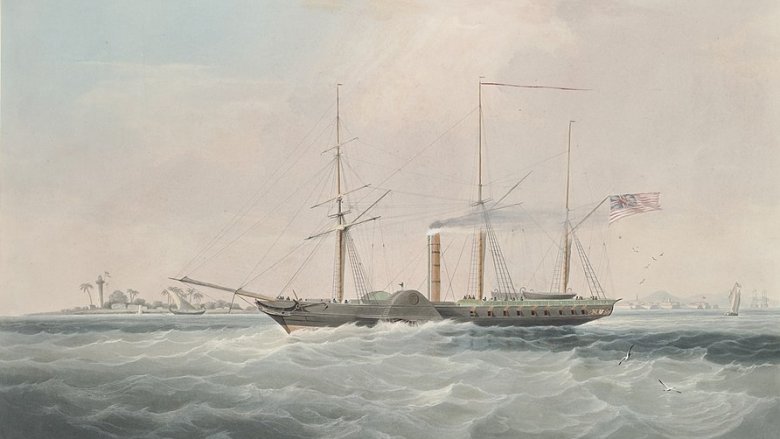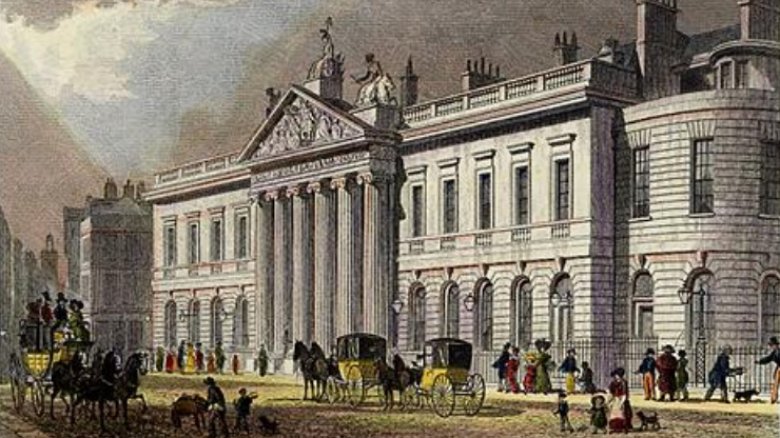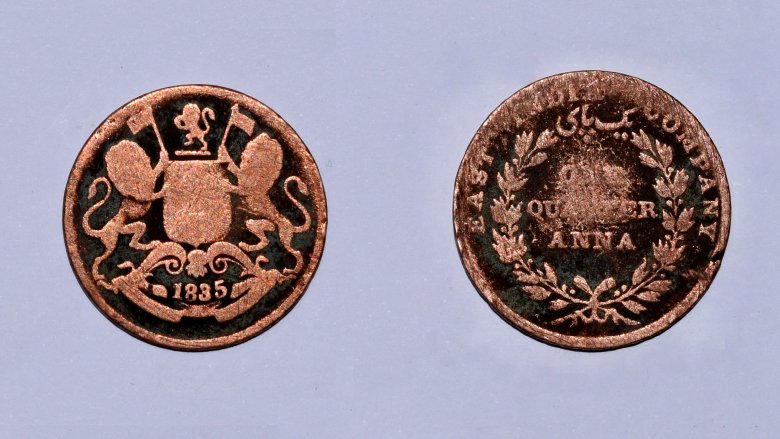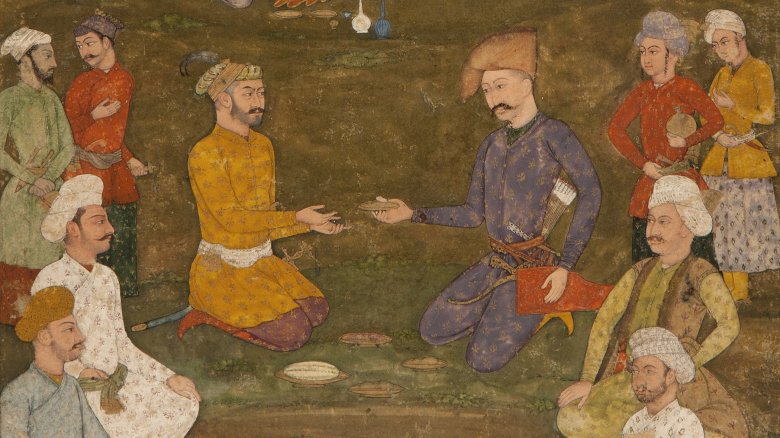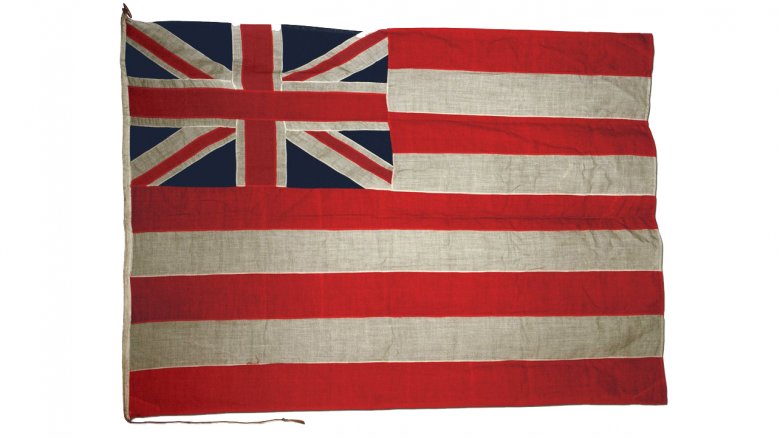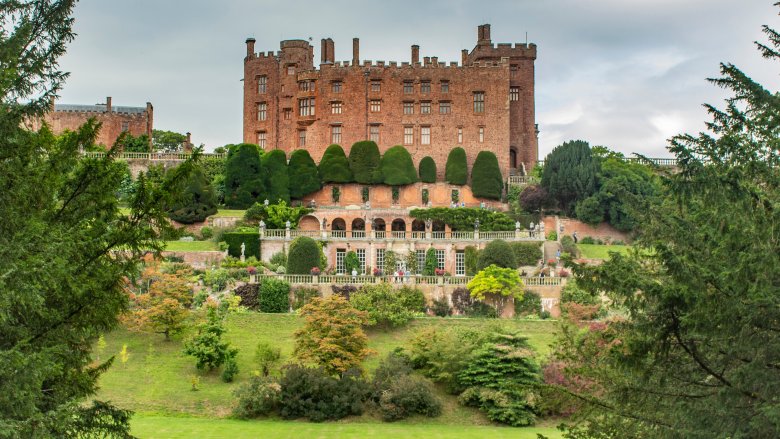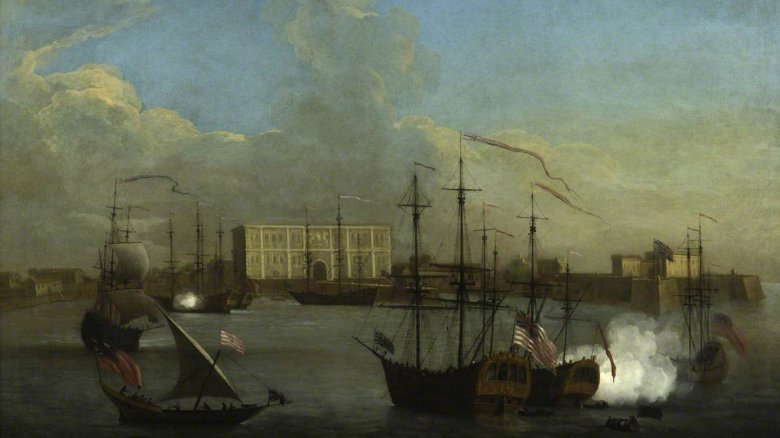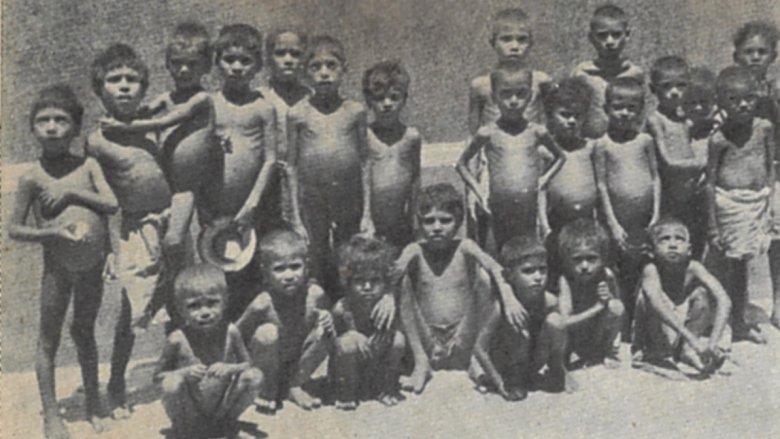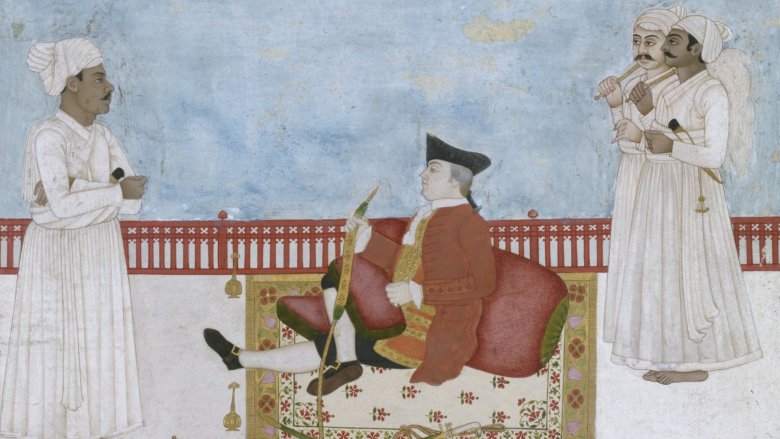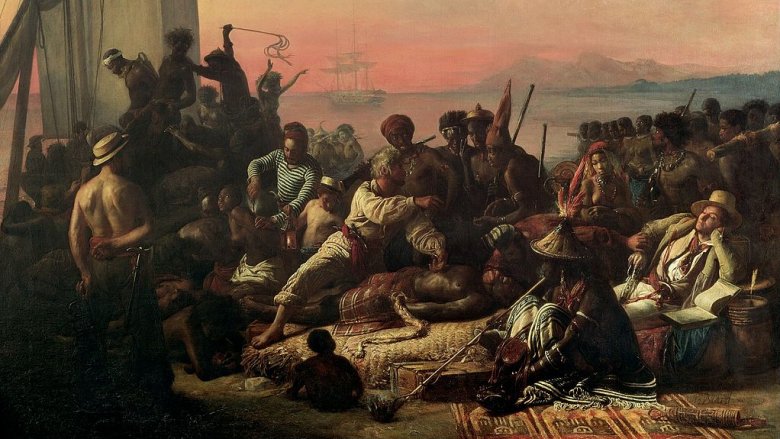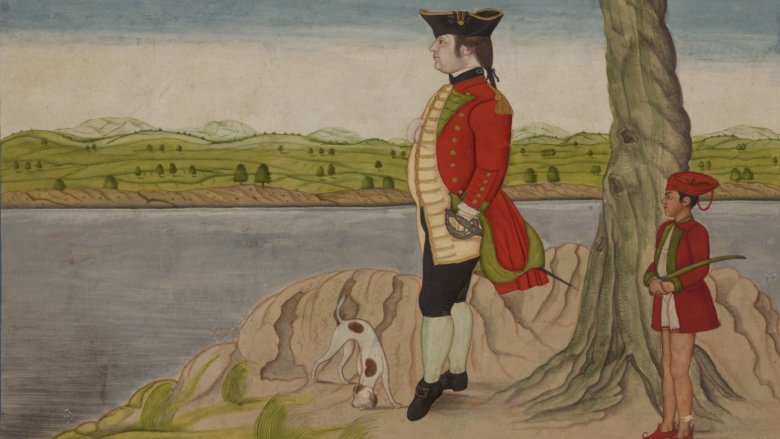The Messed Up Truth About The East India Company
Clap if you trust big corporations. Do you hear the sound of crickets? No one trusts big corporations. Big corporations are in it for their stockholders and their CEO, and ultimately, they don't really give a large rodent's backside about their customers or anyone they trample on the way to lining their own pockets. Harsh words, yes. But the truth hurts.
After all, big corporations have sold addictive, cancer-causing sticks of doom to little kids and built dangerous, toxic factories in a poor, downtrodden neighborhoods ... and it gets even worse. For a historical example of just how evil a big company can be, we only have to go back a few hundred years to the East India Company's reign of terror. You remember those guys — they were the ones tormenting Captain Jack Sparrow in the second and third Pirates of the Caribbean movies. But it should go without saying that their real-life behavior was even worse than what we saw in theaters.
The East India Company, both on and off-screen, is pretty much the poster child of an evil corporation. Just how evil? Well, here's the messed up truth about this notorious organization.
It started as a simple trading enterprise
The East India Company had innocent beginnings. Sort of. It started out as a small, private collection of merchants who were looking to trade spices in Indonesia, because in those days, British food was super bland, and they really, really needed something to make it taste better (or really, to taste like anything at all). Wait, who are we kidding? Millions of dead people later, British food is still super bland, and that somehow makes the whole history of the East India Company so much worse.
Anyway, according to ThoughtCo., the Company was first chartered by Queen Elizabeth I, and the ships set sail in 1601 for the Spice Islands. When the Company got there, the Dutch and the Portuguese were all, "Nope, we got here first," and so the merchants figured they'd maybe just go to India instead. And India was all, "Crap."
Well, not at first. At first, the merchants set up outposts and started trading English wool and silver for silk, sugar, tea, cotton, and opium, because of course opium. There was some pretty valuable stuff moving in and out of those outposts, so it wasn't long before the merchants realized they needed to hire people to help protect the outposts from thieves and various other forms of angry people. That's how a simple trading operation turned into, well, the thing it turned into.
For 20 years, the operation was run out of some dude's house
Not unlike most major Silicon Valley tech companies, in the beginning, the East India Company was run almost entirely out of some dude's house with only six employees on staff. History doesn't seem to remember if the employees had a ping pong table, worked 18 hours a day, and were paid next to nothing on the promise of stock options that never materialized, but it does seem like kind of a risky enterprise for those first six people, who were trying to run a business located halfway across the globe during a time without Skype, the Internet, or phones of any kind. Still, for 20 years, that's exactly what they did. According to Britannica, by 1700 — 100 years after it was first established — the East India Company had grown its London staff to 35 and had moved into a small office in the English capital. By 1785, the permanent staff in its home office had risen to 159.
Take just a moment to internalize that. The East India Company was a corporation that was ultimately responsible for the deaths of millions of people, and it was managed from far, far away by no more than 159 people. Evil comes in strange disguises.
The East India Company starts causing trouble
Written into the East India Company's charter was a provision that allowed it to mint its own money (pictured above), acquire territory, build forts and castles, raise armies, and "wage war" if it was in the interests of Britain and the Company. And naturally, that was all deemed to be in the interests of Britain and the Company, so it's not like its officers were especially shy about using the tools that the crown had given them.
According to History Today, in the early days of the Company, India was ruled by the Mughals, a fabulously wealthy dynasty that was open to trade but had all these pesky ideas about taxation, trading with non-Company traders, and you know, having authority in their own lands. So in 1686, the Company got permission from James II to sail 19 ships from London to India and show the Mughals who was boss. They ended up stuck in a four-year war that ended with an embarrassing defeat. The fleet was scattered, officers and soldiers were taken prisoner, and an army of Mughal soldiers large enough "to have eaten up all the Company's soldiers for breakfast" poured into the Company's Bombay fort. But then, inexplicably, the Mughals decided to let the British stay in India because, you know, they were subdued now and might one day become allies. Ha.
The East India Company takes over India
One of Britain's greatest assets has always been its stick-to-itiveness. The British have never really given up easily, which is how they managed to win the Battle of Agincourt against at least 20,000 well-rested French soldiers with only around 6,000 exhausted, hungry, and sick archers. Back in the day, they also didn't seem to have any real sense of honor when it came to people who were not, you know, British, or at least white European. And when you've got no honor, that means you don't fight fair.
After defeating the East India Company in a four-year war, the Mughals (pictured above) let the East India Company stay in the country, which the East India Company clearly just thought was permission to try and take over. According to The Guardian, the East India Company decided to conquer India in the mid-1700s, and by 1803, it had pretty much done that. Its first act was the subjugation of Mughal emperor Shah Alam in 1765, who after his defeat was forced to dismiss all of his revenue officials in India's major trading cities and replace them with English dudes. Oh, and from that moment on, Mughal taxes would be collected by the East India Company, too — fairly and honorably, of course. (Note the sarcasm.)
And you thought today's corporations had way too much power ...
Just imagine for a moment what it would be like if Amazon took over the entire Western Hemisphere. Oh, wait. Amazon has already taken over the entire Western Hemisphere, so maybe that's a bad example. Okay, imagine if Pottery Barn came along and said, "We're running things now," and then they kicked everyone out of the Senate and the Supreme Court, and when you paid your taxes every year you had to write a check out to "Pottery Barn" instead of the Internal Revenue Service. Now, imagine if they staffed Pottery Barn with slaves, raised an army, and used it to conquer every Crate & Barrel, IKEA, and Restoration Hardware in the continental United States. Plus, picture this Pottery Barn army killing people for shopping at Bed, Bath, and Beyond.
According to The Guardian, that's what happened after Shah Alam handed over control of India's revenue to the East India Company. A few years later, roughly 250 East India Company clerks controlled an army of 20,000 and were basically the country's ruling party. And like any good colonial power, they existed solely to accumulate wealth and territory. By 1803, the Company controlled most of India, and the crazy part is that the British crown wasn't behind any of it. The Company was a small, unregulated corporation in London run by Robert Clive, a man The Guardian calls "an unstable sociopath."
Britain still has a whole lot of Indian treasure
According to The Guardian, Powis Castle is a 13th-century fort in Wales that today serves as a home for the British Empire's plundered treasure. Okay, there's some other stuff there, too, like Roman artifacts, artwork from all over Europe, and some British objects, but the castle also houses a large portion of the loot that the East India Company collected during the 18th century. Evidently, there are more Mughal artifacts in this one Welsh castle than there are in the National Museum of Delhi, which should give you a pretty good idea of the extent of the theft perpetrated by the company.
The loot includes jeweled daggers, handfuls of rubies and emeralds, jade and ivory ornaments, silk wall hangings, and statues of Hindu gods. And really, while there's no real justification for stealing cultural treasures from a foreign nation, the nauseating thing about this collection is that most of it was plundered and then brought back to Britain mostly just so the plunderers could show off how fabulously wealthy they became while engaging in plundering on behalf of the East India Company. And for some reason, no one has actually thought they should maybe give the stuff back.
The East India Company had a ridiculous amount of power
By 1803, the East India Company's conquest of India was pretty much complete. Their army had grown to a massive at 260,000 soldiers, and just for comparison, the size of the United States Army at around the same time was 12,000 men, so yeah. Even if you add in the 5,000 Navy seamen and 1,000 marines the U.S. also had around the same time period, the difference between the size of the American military and the size of the military controlled by a small, private London-based firm was pretty astonishing.
Throughout all of this, the British Crown remained more or less separate from the East India Company. According to The Guardian, Britain spent loads of money protecting the Company's interests in India, but the Company was still able to argue in favor of its continued legal separation from the British government, mostly because there were plenty of people within the British government who owned stock in the Company, and therefore had a vested interest in making sure that the East India Company could keep doing its thing.
They engineered the worst famine in Indian history
Really, the only way a colonial power can justify moving into a foreign nation, setting up a new government, and claiming all of the local riches as your own is if systemic racism is basically the foundation of your entire enterprise. In other words, colonialism isn't possible unless you somehow convince yourself and others that the people you're conquering are lesser than you ... or that they aren't really people at all. After you've done that, any atrocity becomes possible.
According to YourStory, famine was not unheard of in India before British rule, but indigenous leaders actually cared about what happened to their people and, you know, did something about it. The East India Company was above that. In fact, the famines that happened under their rule were engineered by their own greed. They forced farmers to grow inedible, high-value crops like indigo and poppy, but the surplus couldn't be set aside for hard times because it wasn't the sort of thing you could feed your family on. The Company was also charging farming peasants a whopping 50 percent of their cash harvest, and after a bunch of peasants died, they raised the taxes to 60 percent to help recover some of the loss of taxation from all those dead peasants. A staggering 10 million people died, but the East India Company had a banner year with higher profits than it had had in previous years, so hey, what's a few million dead babies compared to that?
They were drug lords
The East India Company conquered a whole country and killed millions of people. So really, the only way the Company could've been much worse is if it was also selling drugs. Hey guess what? The East India Company was also selling drugs. In fact, it wouldn't really be off-base to say they were drug lords. According to Sanskriti Magazine, the East India Company saw the economic opportunity in selling opium, and it really didn't matter to them if there were any moral or ethical problems with it, because profits are more important than people. Sound familiar? (Cough, cough, big tobacco, cough, cough.)
Long after China banned opium-smoking and categorized the sale of opium as a crime equivalent to robbery and instigation to murder, British India was taking charge of the opium trade and actively trying to grow the industry. Believe it or not, the East India Company was so incensed by the audacity of China wanting to protect its people from a dangerous, addictive substance that it waged war on China three times, all over the "right" to sell opium on Chinese territory. By the end of the first Opium War, the Company had not only secured the right to sell opium in five Chinese ports, it had also destroyed much of the coast of China and forced the Chinese to pay $15 million in restitution to British merchants. Britain also got to keep Hong Kong.
They were slavers
You'll be shocked to hear that the East India Company traded in slaves. Actually, you probably weren't shocked to hear that because you're probably so numb already to the East India Company's crimes that you probably didn't even blink when you read that. Yes, the East India Company also traded in slaves. Because when you're already morally corrupt to the depths of your icy black soul, what's a little extra human suffering in the grand scheme of things.
According to Counterpunch, the East India Company trafficked slaves from both Western and Eastern Africa for export to its settlements in India, Africa, and parts of Asia. By the 1730s, it was engaged in large-scale transportation of slaves, which continued into the 1750s and 1770s. It also dealt in "indentured servants," who were really just slaves with politically correct labels. The Company recruited impoverished Europeans to work for them, and the deal usually went like this: Spend four to seven years as the legal property of a rich person in an East India Company settlement in exchange for free transportation across the Atlantic. Um, where do we sign up? That really doesn't sound like an awesome deal, frankly, but it must've worked for the EIC.
At least we have tea and chutney
Now, a couple of centuries later, we can look back at the history of the East India Company with the benefit of modern wisdom. We can ask ourselves how this could've possibly been allowed happen, and we can examine the cultural scaffolding on which the East India Company was built. We can also look for some silver lining, no matter how small, just so we don't have to completely accept the horrible awfulness of it.
So did any good come out of it? Well, according to the Boston Tea Party Ship and Museum, Britain now has afternoon tea. And mango chutney. Yes, those appear to be some of the primary reasons why millions of people had to die. Now, it's true that mango chutney is delicious, and tea is a pretty much the sun around which the entire British solar system revolves. So it's not like there isn't any value to those things, but you know, you can get tea and mango chutney in Canada, too, and Canada never had to take over a whole country and starve a bunch of people to death in order to obtain those particular imports.
Those things probably would've found their way into British culture eventually, anyway. If they hadn't, coffee is a pretty fine substitute for tea. And granted, there's really nothing quite like a dollop of mango chutney on a papadum, but still, even that's not worth the lives of millions of people.
The end finally comes for the East India Company
Most murderous psychopaths eventually attract the attention of some authority figure or another, and eventually, that authority figure goes, "Hmm, maybe we shouldn't let that guy continue to be a murderous psychopath." By the 1850s, India was a pretty collectively sick of the East India Company, and in 1857, there was an uprising. Around 80 percent of the Company's own Indian troops turned on it, killing British soldiers, civilians, and Indians who were loyal to the British.
By then, the East India Company was so sure of their own God-given right to subdue and plunder the nation of India that they thought nothing of both putting down the uprising and then murdering a bunch of people in retaliation. According to Historic UK, the Company killed thousands of combatants and civilians who sympathized with the rebels. Finally, the British government stopped looking the other way and said, "That's crossing a line," and you know it's a pretty big line if it's enough to make colonial Britain squeamish. In 1858, the Crown abolished the East India Company. It didn't actually give India its independence or anything, though. The country remained under British rule for another 89 years.

